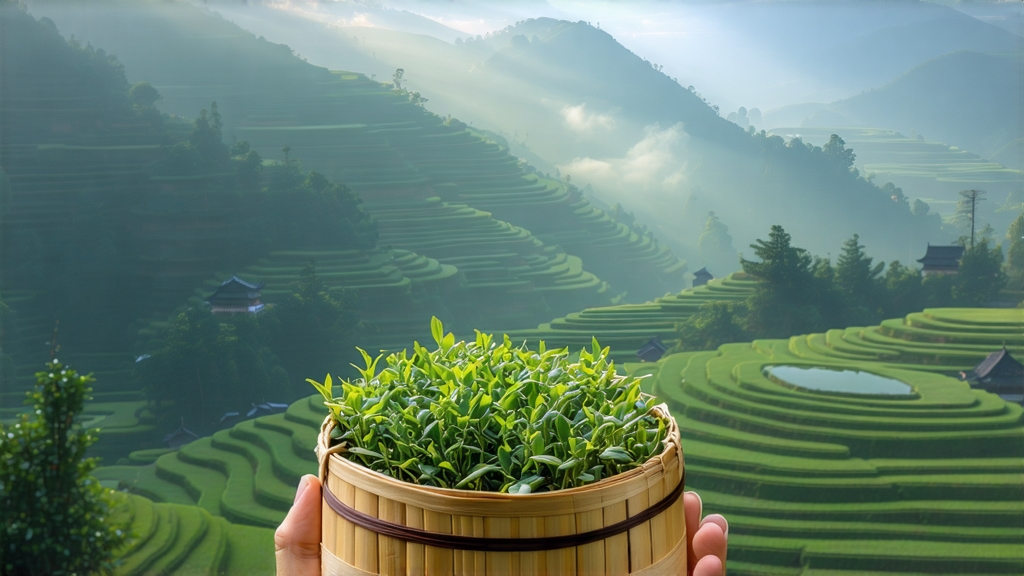
High above the Sichuan Basin, where the Min River carves misty corridors between 30°N and 31°N latitude, the Meng Ding Mountain range rises like a green fortress. For thirteen centuries the summit’s Ganlu Temple has received the first rays of dawn, and those rays fall on the tiny garden that produces Meng Ding Huang Ya—literally “Meng Peak Yellow Bud,” the most discreetly luxurious member of China’s yellow-tea family. While green tea grabs the spotlight and pu-erh courts collectors, yellow tea occupies a slender golden niche: less than 0.3 % of China’s annual tea output, yet historically the first tea an emperor tasted each spring. Meng Ding Huang Ya is its aristocratic flag-bearer, a tea whose story is written in imperial edicts, Song-dynasty poems, and the disciplined patience of artisans who still obey a 70-hour “menhuang” ritual that turns green into gold.
History: from celestial gift to state secret
The mountain’s mythic pedigree begins in 53 BCE when the Taoist monk Wu Lizhen planted seven tea bushes on the summit, believing the site to be the meeting point of earthly and celestial qi. By the Tang dynasty (618-907) the tea was tribute; by Song (960-1279) it was measured out by the grain for the palace pharmacy; by Ming (1368-1644) it had become so coveted that counterfeit leaves from neighboring counties were punished by bamboo flogging. The Qing court formalized the “spring pre-dawn pick” law: buds plucked before the Qingming festival, sealed in silver caddies, and rushed 1 800 km north by relay riders. When the empire fell in 1911 the gardens were abandoned to weeds; the craft survived only because three monks of Ganlu Temple memorized the yellowing chant—an oral score of temperatures, hand gestures, and breathing rhythms—and passed it to a single lay family in 1954. Today 2.1 mu (0.14 ha) of heritage bushes remain, ring-fenced by UNESCO as a Globally Important Agricultural Heritage System.
Terroir: why the mountain makes yellow possible
Meng Ding enjoys a rare “three clouds” microclimate: valley mist at night, summit cloud at noon, and river steam at dusk. The annual 2 000 mm of precipitation arrives in 240 foggy days, filtering UV into a soft silver light that forces the tea bush to synthesize more theanine and less catechin. The soil is a 30-cm humus blanket over purple sandstone, acidic (pH 4.9) and laced with selenium leached from Jurassic strata. Night temperatures drop 8 °C within three hours, locking floral lactones inside the bud. Only two cultivars can metabolize this stress into honeyed quince notes: the ancient “Ganlu #1” (a 300-year-old seeding) and the clonal “Meng Huang #9” released in 1983. Buds must be 12–15 mm long, still wrapped in pale down, weighing 0.12 g each—roughly the mass of a housefly.
Pluck: the one-bud-one-leaf equation
Harvest begins on the first monkey-day after the spring equinox, when villagers still observe the “no iron, no perfume” rule: no metal fingernails, no breakfast garlic, no talking above a whisper. Pickers wear bamboo-weave gloves to avoid hand-oil contamination. The daily quota is 200 g fresh buds per person; 4 kg of buds yield 1 kg of finished tea. Leaves descend the mountain in wicker backpacks lined with banana leaves, arriving at the village workshop within 90 minutes—any longer and enzymatic oxidation would race out of control.
Craft: the seventy-hour alchemy
Yellow tea’s signature is “menhuang,” a slow enzymatic yellowing that sits between green tea’s kill-green and white tea’s withering. Meng Ding Huang Ya uses the most rigorous version, divided into eight acts:
- Sha-qing (kill-green): buds are tossed in a 160 °C wok for 90 seconds, hand pressure never exceeding 300 g/cm² to keep the spine straight.
- Re-wrap: leaves are wrapped in three layers—bamboo skin, cotton cloth, and parchment—creating a 38 °C sauna that drops to 28 °C over 40 minutes.
- Chu-men (first yellowing): bundles rest in a pine-wood cabinet at 28 °C